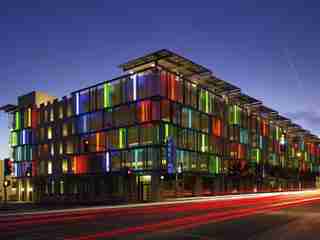It's one thing to design a building, and something more to do so using the entire range of the color wheel as a tool. Yet, architects must be careful. An overuse of colors can quickly turn from an architectural feat, to an eyesore (for more on eyesores, read our round up of the ugliest skyscrapers in the world ). Harnessing their creative might, the architects that designed the thirteen buildings below have proven that a multi-colored building can not only catch ones attention, but make a powerful statement in the process.

Netherlands Institute for Sound and Vision by Willem Jan Neutelings and Michiel Riedijk
Located to the southeast of Amsterdam, Hilversum is known as the epicenter of the Dutch television industry. The Netherlands Institute for Sound and Vision, which is home to the national broadcasting archives, is a structure wrapped in a skin of colorful cast-glass panels.

Kuggen Building by Wingårdh Arkitektkontor
Located on the southwest coast of Sweden in a city called Gothenburg is Chalmers University of Technology. There, the colorful Kuggen Building, which was completed in March 2011, is comprised of six different shades of red and two shades of green that wrap around the structure to stunning effect.

Santa Monica Civic Parking Garage by Moore Ruble Yudell Architects & Planners
In a city that's vying for attention at every corner, it's often difficult to stand out, especially if you're designing a public parking garage. Yet, that's just what the architects at Moore Ruble Yudell accomplished with their design of Santa Monica Civic Parking Garage. There, nine-hundred cars can be stored in the most stylish garage in the city.
The Chapel by A21 Studio
Located on the outskirts of Vietnam’s Ho Chi Minh City, this whitewashed chapel rises on a former vacant lot. Imbued with fluorescent details, the steel-frame structure is lightweight, easy to assemble, and punctuated by a sculptural support column. The community center boasts the title Building of the Year, bestowed on it by the World Architecture Festival in 2014.
Niños Conarte by Anagrama Architects
The goal of this project was to design a contemporary reading and cultural center while preserving the ruins of a historic factory on the outskirts of Monterrey, Mexico. Inspired by the organic shapes of the Sierra Madre foothills, Anagrama created a winsome, fluorescent space that respects the integrity of the original structure.
SAM Monthey Kindergarten by Bonnard Woeffray Architectes
Encased in a series of uniform timber slats, this candy-color kindergarten brightens the somber landscape of Monthey, Switzerland. Bonnard Woeffray Architectes devised a distinctive, evocative structure for imaginative play.
Environmental Education Center El Captivador by CrystalZoo
This education center in the hinterlands of Alicante, Spain, draws on Mediterranean vernacular architecture—the primitive riurau house—to create an organic addition to the landscape. Designed by the young firm CrystalZoo, the institutional structure elegantly unfolds like a labyrinth to sophisticated, vibrant effect.
Sugamo Shinkin Bank by Emmanuelle Moureaux
The French-born, Tokyo-based architect Emmanuelle Moureaux has never been shy about using color. In fact, it’s a bit of a trademark. The Sugamo Shinkin Bank is no different. Here, trees miraculously sprout from paint-chip-encased planters that evoke depth, vibrancy, and expression. Rising in Nakaaoki, Japan, the pixelated grid is an excellent addition to the architect’s Pantone-inspired oeuvre.
BioMuseo by Frank Gehry
Frank Gehry’s first Latin American project, designed as an ode to Panama’s biodiversity, sits on a sprawling nature reserve at the mouth of the Panama Canal. Inspired by the country’s tilted tin roofs, the metal canopies of different shapes and sizes are stacked on top of one another. Inside, concrete trees merge into sculptural canopies, while the colorful design is reminiscent of Panama’s own tropical palette.
Nursery School by Javier Larraz, Iñigo Beguiristain, and Iñaki Bergera
This nursery school in Berriozar, Spain, is traditional at heart. Based on the principles of the Italian municipal schools of Reggio Emilia, the latticed structure, clad in reinforced concrete, orbits around a main courtyard. A luminous second floor creates a light and airy effect throughout.
CMY Pavilion by Shift Architecture Urbanism
Originally built as a video pavilion in 1990 by architect Bernard Tschumi, this dated structure in Groningen, the Netherlands, was infused with new life by Dutch firm Shift Architecture. By applying translucent films in an array of vivid colors to the glass pavilion, the firm created a rainbow-sheathed architectural folly that sits gently on sloping concrete pilotis.
Brandhorst Museum by Sauerbruch Hutton
Nestled into Munich’s urban fabric is a new home for an inimitable collection of contemporary art. The museum, devised by Berlin-based firm Sauerbruch Hutton, is bedecked with 23 polychromatic colors that create the illusion of motion across its façade while simultaneously shading expansive aluminum-clad windows.
The Number 6 by Building Engineering
In Turin, Italy, a 17th-century palazzo has undergone a refined transformation into a modern apartment building and art space. Italian studio Building Engineering left the ornate Baroque architecture intact while inserting a sense of whimsy into the staid quarters through experimentations with light and space. With synchronized LED lights and light-raked walls, the fantastical structure seamlessly blends past and present.

Leave a Reply